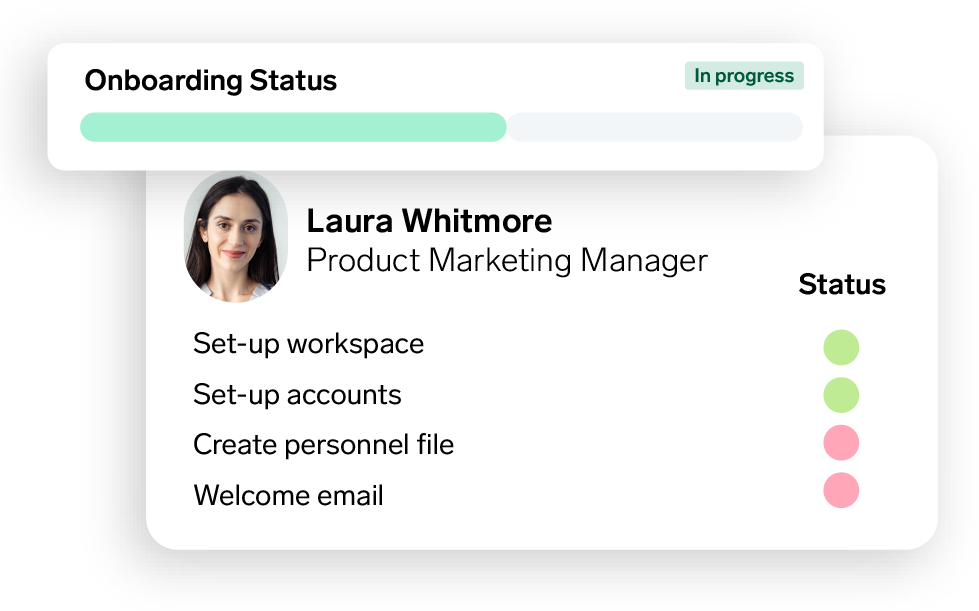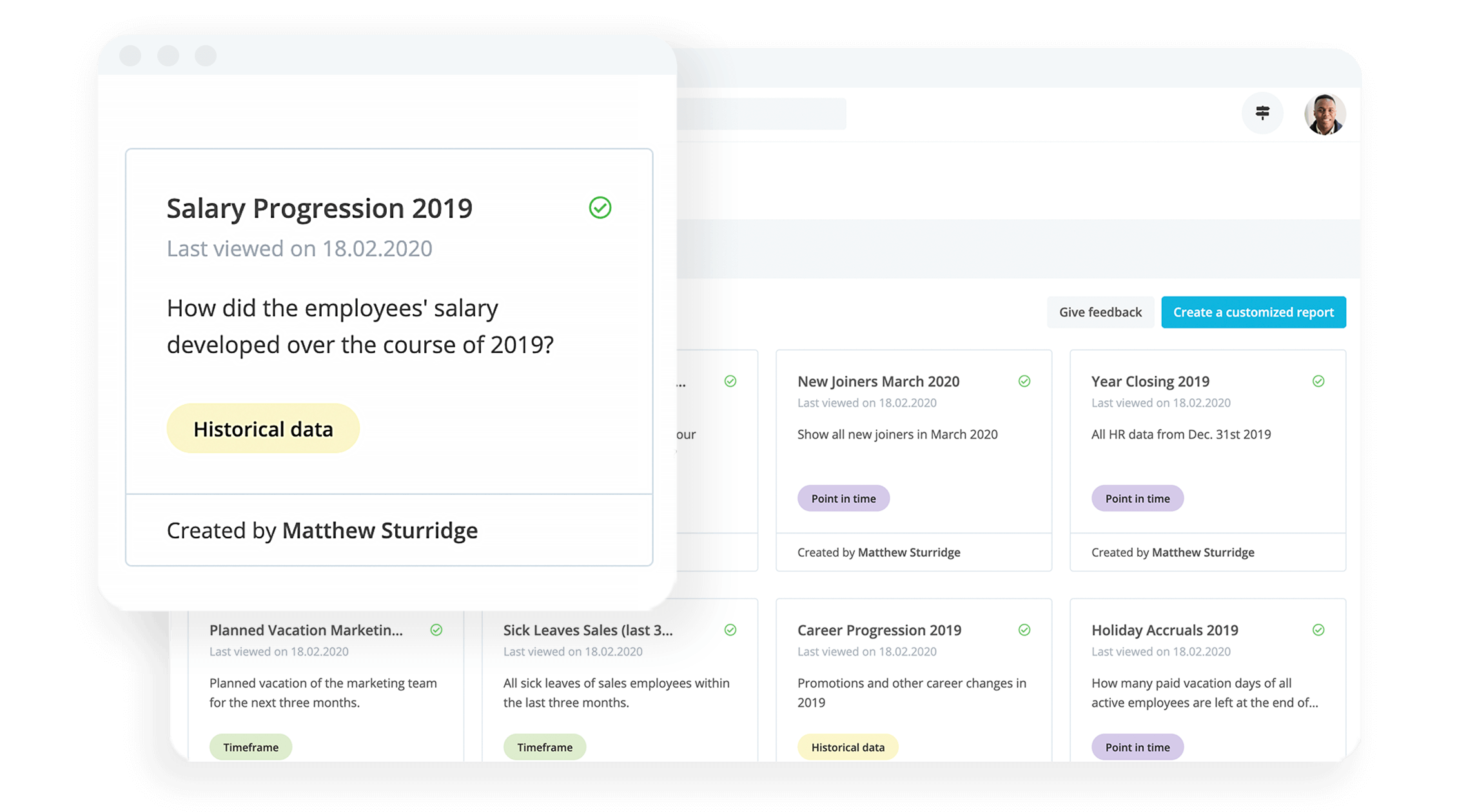Automate these 10 HR workflows for peak efficiency

How can your HR department do more with less? In a world of ever-tightening budgets and increased pressures to reach peak productivity, one of the answers out there might be for organisations to better leverage HR workflow automation.
In this article, we’ll take you through the top ten HR workflows that organisations should seek to automate for maximum efficiency. Then, we’ll tell you a bit more about how to make it possible with a flexible, user-friendly HR software.
Contents
- 1Why automate your HR work?
- 2Turning candidates into employees
- 3Collecting information from new employees
- 4Tracking time and attendance efficiently
- 5Making leave requests more streamlined
- 6Scheduling and running performance cycles
- 7Making changes with employee self-service
- 8Sending out contract amendments
- 9Answering employee questions with an HR helpdesk
- 10Ensuring employee training happens on schedule
- 11Elevate your HR work through automation
Why automate your HR work?
When we talk about automation, we’re not simply talking about replacing tasks or replacing people. Instead, it’s a conversation around how things run.
For many HR processes across the employee lifecycle, HR teams are often burdened with managing multiple steps, stakeholders and loads of administrative tasks and to-dos along the way. For an organisation of any size, it simply doesn’t work for long.
To do great work at scale, teams need to be able to leverage automation. When that’s facilitated by great tools, automation can help ensure that processes run, that they run well and that they’re a pleasant experience for all involved.
This helps achieve three critical outcomes:
It gives yourself and your HR function the time to focus on more strategic, value-adding initiatives for your organisation. Imagine being able to focus on promoting culture rather than managing paperwork.
We make it far easier for employees to focus on their own work, rather than having to juggle a host of tasks to make simple requests. Think about how easy it could be to request vacation or track their time.
Lastly, we give leaders and executives not only time back, but equip them with the tools to host more meaningful performance conversations, attract and retain their highest performers and have the data they need to hand on their people.
Sounds like a winning proposition, doesn’t it? To be fair, though, not all automation is created equal. Your team needs to focus on areas where you can leverage automation the most, and make it count to the highest degree. In short, you need to choose wisely.
These are the ten HR workflows that can lead to the biggest benefit for startups all the way through to SMEs in the UK…
1. Turning candidates into employees

Your average applicant tracking software (ATS) is already going to introduce a good amount of automation into your recruitment processes. It should be able to help with things like scheduling interviews, collecting feedback and moving candidates through various stages.
But, what happens when you find that perfect candidate? One of the things you’re going to need your HR software to do is complete the incredibly-important offer-to-employee workflow. This is where a top candidate becomes a new joiner.
Being able to send an offer letter, collect the requisite signatures and then turn that candidate into an employee in your system is a massively-critical workflow. If your HR software can’t handle this stage, you may need to rethink its suitability.
2. Collecting information from new employees

The onboarding phase can make or break the success of your organisation. That’s because the efficacy of your onboarding processes typically has a distinct effect on employee performance, satisfaction, engagement and long-term retention.
We need to leverage automation to set us up for success from the start. A great onboarding process moves in phases, when we automate those phases we can help:
Collect the right information at the right time
Ensure employees are connected to the right stakeholders
Remind relevant parties to loop in and out of the process
When all of these things are firing on all cylinders, then new employees are treated to a flying start. This also ensures that HR teams spend less time ensuring that the process runs at all — and more that it is a pleasant experience for new talent.
3. Tracking time and attendance efficiently
Employees should have the ability to clock in and out electronically, when and where it makes sense for them, complemented by a system that automatically tracks hours worked, overtime and breaks — eliminating the need for manual timesheets.
As far as tracking time is concerned, that’s a common HR workflow that needs to be user-friendly for employees to make the most of it. On the other side of the coin, HR needs a system that can serve as a single source for all relevant data.
This saves HR teams countless hours managing timesheets and chasing down missing entries. It also improves accuracy and reduces the risk of errors when it comes to processing payroll. Ultimately, organisations can benefit from better data for project costing and workforce planning.
4. Making leave requests more streamlined
When you don’t have HR software or a way to automate leave management, it can quickly become a cumbersome and frustrating process for all involved — especially for HR teams and employees.
Offering employees an automated way to request leave, managers a way to review and approve that leave and a single source for HR to monitor leave, everyone benefits! This is especially true when it comes to automating leave entitlements.
How many days does an employee have left? Does this differ across locations like the UK and Ireland? How about bank holidays — are they already in the system?
Properly automated leave management processes saves countless hours of employee and HR frustration. It also empowers employees to manage their own leave and check in whenever it makes sense for them.
5. Scheduling and running performance cycles

Employees care deeply about their development, and performance review season is one of the most nerve-wracking times of the year. Funnily enough, it can be just as nerve wracking (if not more) for your average HR team.
That’s because it is incredibly difficult to run seamless performance management cycles! There are so many people you need to loop in, forms to fill out, salary increases to note and many other steps that makes the process incredibly cumbersome and frustrating.
Automation can step in to help run performance cycles at scale. With the right tools to hand, you can create a review cycle, add employees to it, choose the forms that make the most sense (with handy templates) and then hit ‘Run.’ The rest should run like clockwork.
6. Making changes with employee self-service
What happens when one of your employees gets married? Change their address? Opens a new bank account and needs to get paid a different way? Is the process as seamless as it should be — for many teams, it takes far too much.
That’s because HR teams are almost too involved with these minute changes. It takes up far too much time, and takes time away from more productive measures (like the strategic ones we’ve listed above). Employee self-service (ESS) can be a big help.
Given the right ESS system, you can automate the process of making changes. Here’s how that might look step by step:
An employee moves house and needs to change their address
They open their HR software and update their address in their profile
HR is automatically notified (via email, if necessary)
A member of the HR team can see the change in a centralised dashboard
They can approve the request and we’re done!
No muss, no fuss, an employee has their information updated in record time and without requiring HR to go chasing for documents or approvals. Everything still remains accurate with the right permissions, but things move far faster.
7. Sending out contract amendments
What happens when a policy changes at your organisation? If it involves ticking boxes and following up with employees of all stripes, you may have a problem on your hands.
An underrated element of HR workflow automation is being able to make a change to a policy and sending out updated employment contracts, even when signatures are required, out to your entire workforce. In a single click!
You could also do this on an employee-by-employee basis. Here’s an example: Let’s say you’ve agreed with an employee to enjoy sabbatical leave. As part of a new contractual agreement that proposes a salary saving proposal can be drawn up, sent to that exact employee for them to sign and sent back and saved to your HR records.
Done and dusted in record time. And, most importantly, all of these contract documents stay securely within a single system.
8. Running automated reports

Traditionally, generating reports on headcount, turnover or time off accruals can be a time-consuming manual process. At the same time, HR departments are being asked to be more and more data driven in how they work.
There’s a critical role for automation here. By integrating your employee data within one system, reports can be easily and automatically generated on a predefined schedule.
Let’s say you want to run a quarterly report on headcount and staff turnover. By building out automation, you can have a report generated and presented in a single dashboard that can then be reported to managerial or executive-level stakeholders.
Ultimately, this frees up HR professionals to analyse the data, identify trends and make data-driven decisions for the organisation.
9. Answering employee questions with an HR helpdesk
An HR helpdesk or chatbot, fully integrated with your HR system, can act as a friendly first point of contact for employee questions. This can help ensure that your HR team is running a high level of HR service delivery.
This 24/7 resource can answer frequently asked questions about benefits, policies and a variety of other topics. The chatbot can also direct employees to the right resources or escalate complex inquiries to the HR team, saving them valuable time.
From the other side, this kind of automation can also help generate reports and valuable data for HR teams. Things like:
The number of requests submitted
The number of requests successfully answered
Task status and progress
Employee satisfaction scores
Time-to-resolve and time-to-respond metrics
All of these can help ensure that HR teams are delivering a high level of service, and helping employees get what they need without having to spend time constantly intervening.
10. Ensuring employee training happens on schedule
Developing your employees should be a topic at every organisation. Things like internal mobility and training can help employees develop their skills, boost productivity and maintain a high level of engagement and morale across your organisation.
But, every employee is different. This makes the process of designing, offering and tracking training courses a bit more complex. A common HR workflow automation here involves easily enrolling employees in courses that they themselves can complete.
An HR professional chooses the course and the required attendees, at which point employees are notified of their need to attend the training. Once they complete the course, HR is notified in turn and can keep track of who has — and hasn't — completed the course.
Now, your team has the time they need to spend it assessing development paths to upskill your workforce at scale.
Elevate your HR work through automation
Don't simply automate your HR processes, empower them.
Personio is an HR solution that is flexible to the needs of your business. Our solution can help introduce automation at scale, and help run workflows that touch each and every stage of the employee lifecycle.
We’d hardly expect you to just take our word for it. Start a free trial today to get your head around our system, and then speak with an expert to learn about how we’ve helped 10,000+ organisations drive impact where they work.

